Rathbraughan
Houses within 10km of this house
Displaying 60 houses.
Houses within 10km of Rathbraughan
Displaying 60 houses.
| House name | Description | |
|---|---|---|
| Seafield or Lisheen | At the time of Griffiths Valuation, William Phibbs owned a house at Lisheenacooravan valued at £55. This house was known as Seafield or Lisheen at different times. In 1906 Seafield/Lisheen was valued at £55. The property is now a ruin |

|
| Ellenville or Ardaghowen | The first edition OS Map suggests the house on this site was known at that time as Ellenville. It is now known as Ardaghown, still extant but derelict and was under renovation in 2006. McTernan indicates that it was originally built as a dower house for the Wynne estate. In the 1850s it was held by Owen Wynne from Capt. James Martin and valued at £35. |

|
| Percymount | At the time of Griffith's Valuation John Wynne held this property at Kiltycahill, when it was described as "Painter's house" and valued at £5. The property had been owned by the Gethin family until its sale in the Encumbered Estates Court in the early 1850s. McTernan states that races were frequently held on the lawn at Percymount between the 1870s and the 1940s. The house is now in a derelict condition. | |
| Hazelwood | Hazelwood was designed for Owen Wynne by the architect Richard Castle and built between 1720 and 1740. Reverend William Henry's account of Sligo in 1739 contains a detailed account of the house. Wilson describes it in 1786 as "a fine and elegant seat". It remained the home of the Wynne family for 200 years. At the time of Griffith's Valuation it was owned by John Wynne and was valued at £120. The estate was sold to the Land Commission in the 1920s and the house has had various uses including army accommodation, psychiatric hospital and more latterly, part of an industrial building. Though neglected it survives intact. |

|
| Doonally | The Parke family were granted lands at Doonally (or Dunally) in the 17th century. These lands had previously belonged to the O'Connors. The building currently at this site was built c.1830. It was the property of Roger Parke at the time of Griffiths Valuation and was valued at £40. In 1906 it was valued at £44. In the mid-twentieth century it was sold to the North West Cattle Breeders Association and used as an administrative headquarters. It is now vacant but rapidly becoming derelict. |

|
| Culleenamore | At the time of Griffith's Valuation, Samuel Barrett was leasing the house at Culleenamore, barony of Carbury, from Edward Nicholson, when it was valued at £16. | |
| Grange/Primrose Grange | Richard Gethin was leasing a house at Primrose Grange to Christopher Allen at the time of Griffith's Valuation when it was valued at £14. McTernan notes this as Grange House, built in the eighteenth century and enlarged c.1820. It was leased to a succession of families thoroughout the nineteenth and twentieth centuries and was eventually demolished in 1981. A building formerly used as a school is stil extant and lived in. |

|
| Cummeen (also spelt Cummin) | The Ormsby family had a house at Cummeen, Coolera in the eighteenth century. Wilson noted it as the residence of John Ormsby in 1786, when he describes it as "a magniificent and beautiful seat". At the time of Griffith's Valuation the representatives of Charles Ormsby were leasing the house and land at Cumeen to William Phibbs who in turn leased the house to Alexander Wylie. It was valued at £13. Some building remains and a possible folly are still visible at the site. |

|
| Rathcarrick | At the time of Griffith's Valuation there were two substantial houses at Rathcarrick, barony of Carbury, both belonging to the Walker estate. John McHutcheon was leasing one property valued at £18 while Amy Eliza Walker was leasing the second, valued at £28. In 1906 John F. Walker was the owner of a house at Rathcarrick, then valued at £63. Rathcarrick house is still extant and has recently been renovated. |

|
| Cloverhill | Cloverhill was part of the Earl of Erne's estate in county Sligo. At the time of Griffith's Valuation, it was leased to William C. Chambers when it was valued at £28. In 1786 Wilson had noted it as a seat of "Mr. Chalmers" so it had been occupied by that family since the eighteenth century. Cloverhill House was demolished in 1988. Some remains of estate walls visible. | |
| Breeogue | Matthew Walsh was leasing this property from the Earl of Erne's estate at the time of Griffith's Valuation when it was valued at almost £6. Breeogue House is still extant and occupied. |

|
| Kevinsfort | Kevinsfort House was built c.1820. It was the home of various other families at different times in the 19th century, including Capt. George Dodwell. At the time of Griffith's Valuation it seems to have been leased by Alexander Popham to John Stoll and valued at £52. McTernan notes that Popham was Dodwell's son-in-law. The property was sold by the Pophams in 1923. Kevinsfort is still extant and occupied. |

|
| Cleveragh | Capt. James Martin was the lessor of a property valued at £18 at Cleaveragh Demesne, barony of Carbury at the time of Griffith's Valuation. It was being leased by Robert Wilson. It continued in Martin ownership until the twentieth century though frequently occupied by tenants. The house and demesne were eventually bought by Sligo Borough Council with the intention of creating a town park though this was only partially realised. The house was demolished in 1999. | |
| Woodville | Woodville House is still extant and occupied by the Wood family who operate an open farm there. At the time of Griffith's Valuation, it was being leased by Alicia Martin from Capt. James Wood and was valued at £42. |
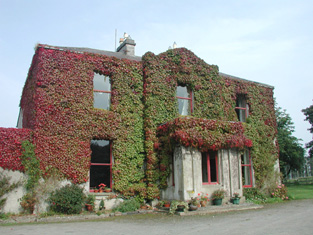
|
| Clogherevagh | The house at Clogherevagh now forms part of St. Angela's College, a constituent college of NUI, Galway. The National Inventory of Architectural Heritage estimates that the house was built c.1890. At the time of Griffith's Valuation much of the townland was the property of John Wynne's estate. In 1894 Slater notes it as the residence of John Cochrane. |

|
| Avena | McTernan indicates that this house was originally owned by Robert Culbertson, mill owner of Ballysadare. His property was purchased in the Landed Estates Court in the 1860s by Messers. Middleton and Pollexfen and became a regular residence of Wiliam Middleton. It is still extant and occupied. |
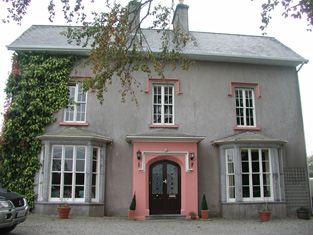
|
| Parke's Castle | This castle was built by Capt. Roger Parke, incorporating an old O'Rourke castle, probably in the first or second decades of the 17th century. This property eventually came into the possession of the Gore family through the marriage of Anne Parke to Sir Francis Gore. |
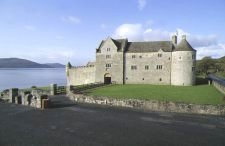
|
| Newtown Manor | A house built after the publication of the First Ordnance Survey map. John James Whyte held this property in fee at the time of Griffith's Valuation, when itwas valued at £12. Slater notes that it was the residence of Captain Edward T. Pottinger in 1894. In 1906 Charles B. Whyte was the owner of the house at Carrickfad valued at £22. It is no longer extant. | |
| The Hermitage | At the time of Griffith's Valuation, Harper Campbell was leasing a property at The Mall, Sligo, valued at £41. It had been purchased by him in the Encumbered Estates Court in 1855, having previously been the property of a member of the Wynne family. McTernan notes that it was destroyed by fire in 1976 and the site is now occupied by educational buildings. | |
| Doonaleragh Lodge | This house was built as a summer house for the family residing at Rathcarrick. At the time of Griffith's Valuation, Amy Eliza Walker was leasing it and over 300 acres from the representatives of Roger Walker. It was valued at £10. It is still extant and occupied. |

|
| Glen Lodge | Around 1780 James Sandford Nicholson settled in the newly built family seat which he named Glen Lodge. It was in the possession of Thomas White at the time of Griffith's Valuation who was leasing it to James Coghrane when it was valued at £15. At the time the estate was sold in the Landed Estates Court in 1876 Glen Lodge is described as "a good residence, leased by the Court of Chancery to Andrew James for 7 years from 1869". The house is still extant and occupied. |

|
| Finned House | In 1906 Sir Jocelyn Gore Booth owned buildings valued at £8 at Finned, barony of Carbury. This is likely to be Finned House. This townland was the property of the Gore Booth estate at the time of Griffith's Valuation but the highest building valuation at that time was only £2. | |
| Ballygilgan Gate Lodge | In 1906 Sir Jocelyn Gore Booth held over 800 acres of untenanted land at Ballygilgan as well as a house valued at almost £9. |
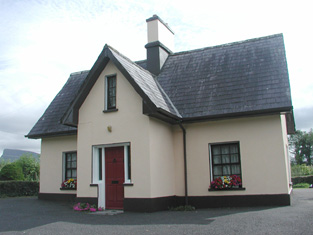
|
| Elsinore | At the time of Griffith's Valuation, Edward Cooper owned a property at Rosses Upper, barony of Carbury, valued at £16. In 1906 the representatives of William Middleton held a property here valued at £18 as well as over 350 acres of untenanted land. The property also has associations with W.B. Yeats who used to spend holidays here with the Middleton family. The house is now a ruin. |

|
| Abbeytown | In 1906 Mrs. H. Campbell owned a property valued at £5 as well as over 100 acres of untenanted land at Abbeytown, [Grid reference is approximate] | |
| Willowbrook | At the time of Griffith's Valuation, Andrew McCullough was leasing a property at Willowbrook, valued at £13, from Mrs. Ormsby Gore. In 1906 Lord Harlech's estate owned property valued at £3 at Willowbrook, barony of Carbury. McTernan notes that the house was accidentaly destroyed by fire in December 1867. The ruin is still visible. | |
| Wynnesfort House | In 1906 Alexander Lyons owned a property valued at £8 at Rahaberna, barony of Carbury. At the time of Griffith's Valuation this property was leased from the Lyons estate by George Robinson. McTernan states that the lands passed from the Knox to the Wynne estate in the late eighteenth century. In the early nineteenth century William C. Wood of Rathellen had possession and the house was let to a succession of tenants. It was sold in the Encumbered Estates court in 1853 when the purchaser was Henry Lyons. | |
| Mount Shannon | At the time of Griffith's Valuation, Francis Olpherts was leasing Mount Shannon, barony of Carbury from John Wynne. The house was then valued at £35. McTernan states that Olpherts had recently been appointed agent to the Wynne estate and later married Marianna Wynne of Ardaghowen. The house is still recorded by Slater as being in his possession in 1894. It has had a number of owners since the early twentieth century but is still extant and occupied. |
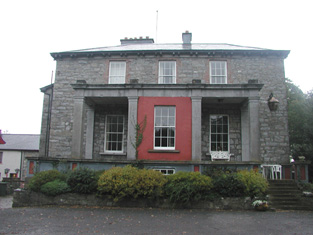
|
| Ballyglass House | Ballyglass House was in the possession of the Rev. William Gillmor at the time of the sale of lands in November 1854. There were two substantial houses in Ballyglass townland at the time of Griffith's Valuation in 1856. One, valued at £16, was leased from John Wynne by Rev. Gillmor, while the second was being leased from him by James Duncan. McTernan notes that it was purchased from Gillmor by Peter O'Connor and used by members of that family up until the twentieth century. Slater records it as his seat in 1894. It is still extant and occupied. |

|
| Cregg House | Michael Jones, formerly of Lisgoole, county Fermanagh, is described as of Cregg House in 1854. His representatives still held the property in the 1870s. At the time of Griffith's Valuation, it was occupied by Capt. Alex Lumsden, son-in-law of Michael Jones, leasing from John Wynne, when it was valued at £25. Cregg House afterwards came into the possession of the Sisters of La Sagesse and is now a Special Needs facility. |
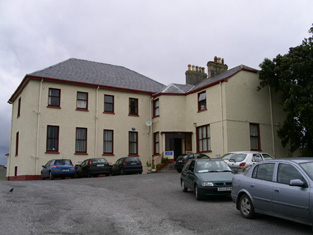
|
| Faughts Cottage | At the time of Griffith's Valuation, Phillip Parke was leasing a property at Faughts, barony of Carbury, valued at £7, from John Wynne. This appears to be the house described on both the First and 25-inch edition Ordnance Survey maps as "Faughts Cottage". A house is still extant at the site. | |
| Castlegal House | At the time of Griffith's Valuation George Dunne was leasing two properties in the townland of Castlegal to the Parke family. John Parke was renting a house valued at £7 together with 50 acres while Phillip Parke was leasing a house valued at £5 and 98 acres. McTernan states that prior to being owned by the Dunn family this property belonged to the Cope estate. Castelgal is still extant and occupied. | |
| Rahelly | Francis Barber was leasing a house at Rahelly, barony of Carbury, from the Gore Booth estate at the time of Griffith's Valuation, when it was valued at £25. Rahelly later fell into ruin but has been restored and offered for sale in recent times. |

|
| Kilboglashy | At the time of Griffith's Valuation, Harloe Phibbs was leasing a house valued at £8 as well as mill buildings valued at £300 to Robert Culbertson, at Kiboglashy, Almost all traces of the huge mill complex in Ballysadare have now been demolished and modern building development has taken place there. |

|
| Millbrook House(Drumcliff) | Edward Simpson was leasing a house, mill and associated buildings at Ballincar, barony of Carbury valued at £16 from the Wynne estate at the time of Griffith's Valuation. He offered the property for sale in the Landed Estate's Court in April 1873. The sale notice indicates that he held it on a Fee Farm Grant from Owen Wynne dated 1868. The original house is no longer extant. | |
| AbbeyView | At the time of Griffith's Valuation, Alexander Phillips was leasing a house valued at almost £14 at Abbeyquarter North, barony of Carbury, from the Cooper estate. McTernan states that it was built in the later eighteenth century and described in 1878 "as a beautifully situated villa residence with attractive grounds". The Phillips family continued in residence until the 1860s after which it was occupied by a succession of owners until the 1990s when it was sold to the Electricity Supply Board who demolished the house. | |
| Holywell | In his 1802 description of the Wynne estate McParlan mentions that Rev. Richard Wynne was about to build at Holywell, along the shore of Lough Gill. At the time of Griffith's Valuation John Wynne was leasing the house in Cloghermore to James Patterson when it was valued at almost £7. In 1894, Slater refers to it as the seat of Captain Gethin. This house is still extant and has recently been extensively renovated. |

|
| Oxfield | At the time of Griffith's Valuation, Oxfield House was the caretaker's residence for the plantation of over 150 acres owned by the Gore Booth estate at Cullaghmore, barony of Carbury. | |
| Springfield | The Phibbs estate owned several houses as well as the townland of Springfield or Magheralgillerneeve, barony of Carbury at the time of Griffith's Valuation. One house, valued at £12, was being leased by John Mullan. | |
| Tully House (Carbury) | Charles Simpson was leasing a house valued at £6 at Tully, barony of Carbury, from the Wynne estate, at the time of Griffith's Valuation. A house is still extant at the site. | |
| Strandhill House | At the time of Griffith's Valuation George D. Meredith was leasing Strandhill House, valued at £9, from the estate of William Phibbs. McTernan states that the house remained in the Meredith family until the 1960s. It is now a roofless ruin. | |
| Rockville (Carbury) | Edward Homan was leasing two properties, both valued at over £4 and described as Bathing Lodges, at Culleenamore, from Samuel Barrett, at the time of Griffith's Valuation. One house is noted on the OS 1st edition sheet as Rockville and the second as Bocage. | |
| Lisnalurg House | George Robinson was leasing Lisnalurg House from the Wynne estate at the time of Griffith's Valuation when it was valued at £14. McTernan notes that it was sometime the accommodation of the estate agent. It is still extant and occupied by descendents of the Wynne family. | |
| Belleview Cottage | Robert Whiteside was leasing the property at Lisnalurg, known as Belleview Cottage from the Wynne estate, at the time of Griffith's Valuation. It was valued at £8. The site is now occupied by a house known as Ardeevin | |
| Summerhill (Carbury) | At the time of Griffith's Valuation, John Gowan was leasing a house valued at £6 at Lisnalurg, from the Wynne estate. This is the house known as Summerhill which, in the 1870s, was acquired by the Anderson family who remained in possession until 1922. It is still extant. | |
| Violet Hill | At the time of Griffith's Valuation Thomas McDonnell was leasing an extensive mill complex and a house at Shannon Oughter, from the Martin estate. The entire property was valued at over £30. | |
| Colgagh House | Edward Homan was leasing a property valued at £18 from the Ffolliott estate at Cogagh, parish of Calry at the time of Griffith's Valuation. McTernan writes that the Homans continued in residence until the 1880s. Colgagh House is still extant and occupied. |

|
| Ballytivnan House | McTernan writes that this was a 2-storey eighteenth century residence, occupied by the Griffith family until the 1830s. Following them it was the home of Jack Taaffe and was damaged on the night of the Big Wind in January 1839. It was later occupied by the Kelly family. Afterwards acquired by the Health authorities and subsequently demolished. | |
| Cairnsfoot | McTernan indicates that Maj. De Bromhead is the reputed builder of Cairnsfoot, probably in the early decades of the nineteenth century, when he leased the lands from the Cooper estate. He had married Judith Wood in 1823. In the 1840s he returned to England and the house was let to a number of different families, notably the O'Connors. In 2004 it was partially destroyed by fire and subsequently demolished. | |
| Rathanna | Col. Knox Barrett held this property from Jane Mullin at the time of Griffith's Valuation when it was valued at £20. It remained in the Barret family until the early 1900s when it was sold to the Monahan family who owned it until the 1960s. McTernan writes that it was sold to the Jurys Hotel Group who built the Sligo Park Hotel in front of the original house which was demolished in the 1980s. | |
| Rathellen | McTernan writes that Rathellen was built at the beginning of the nineteenth century as a dower house for the Wood of Woodville estate.. It was purchased by Henry Lyons in 1860 and remained in the Lyons family until the 1940s. It is still extant but unoccupied. | |
| Rose Hill (Sligo) | McTernan writes that this was originally the residence of Thomas Reed and known as Lakeview. It passed to his son-in-law, Vernon Davys, in the early 1830s. After the 1840s it was leased to a succession of tenants. It was demolished in the 1980s to make way for modern housing. | |
| Arnasbrack | Nicholson Ormsby Fury was leasing a house valued at £5 from the Cooper estate at the time of Griffith;s Valuation. McTernan states that it was the modern seat of the Fury family of nearby Castle Fury. In the early twentieth century the family sold their interest in the property. The house is still extant and occupied. | |
| Drumcliff | The townland of Drumcliff South formed part of the Gethin estate in this area in the eighteenth century. This house was leased to Charles Allen at the time of Griffith's Valuation, when it was valued at £12 10s. The house had a succession of owners in the twentieth century and is still extant and occupied. | |
| Lower Shannon House | John Duncan was leasing this property from the Wynne estate at the time of Griffith's Valuation, when it was valued at £10.McTernan notes that it was purchased by his relatives from the Wynne estate in the early twentieth century. The property was sold again in the 1920s to the Donaghy family and continues in their possession. | |
| Moorfield Cottage | Jeremiah Rogers, a steward on the Gore-Booth estate, was occupying this property at the time of Griffith's Valuation, when it was valued at £5 10s. McTernan states that it remained in the Rogers family until the early decades of the twentieth century. It is still extant and occupied. | |
| Finisklin House or Seamount | Built as a seaside residence of the Wood family though frequently leased by them to various other families. In the mid nineteenth century it was the residence of Thomas Mostyn Wood and valued at £11. In the 1870s, McTernan notes that it passed to the land agent Richard St. George Robinson, in whose family it remained until the early twentieth century. It is still extant and has been restored. | |
| Urlar or Beckfield | Leased by William Hamilton,MD, from the Gore-Booth estate at the time of Griffith's Valuaiton when it was valued at over £10. McTernan notes that it was previously held by the Munns family and later in the nineteenth century by George Somerville. Labeled as Beckfield on the First Edition Ordnance Survey Map. It is still extant and undergoing restoration. | |
| Belvoir (Sligo) | Wilson refers to Belvoir, situated on the other side of the Garavogue river from Hazelwood, as the seat of Mr. Ormsby in 1786. By the time of Griffith's Valuation, the property here is held by John Wynne and referred to as "a servant's house", valued at £2 15s. Buildings are still extant at the site. | |
| Oakfield House (Sligo) | In 1786 Wilson notes a house close to Cloverhill House as the seat of Mr. Deboots [?]. This may be Oakfield House. At the time of Griffith's Valuation, this property was leased from Captain Richard Gethin by Joseph Holmes. It is described as a herd's house and was valued at £3 10s at the time. An extensive farm is still extant at the site. |

